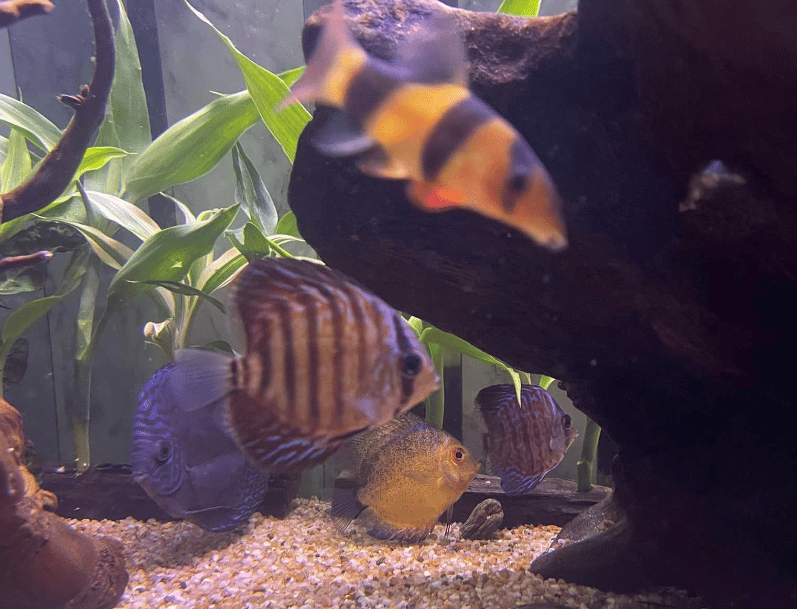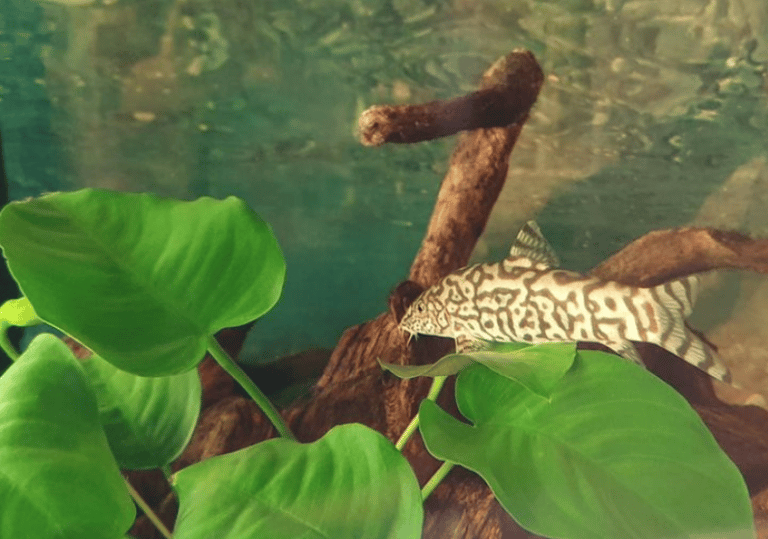Tiger barbs and discus are beautiful fish to have in an aquarium but their personality and water requirements make it difficult to keep them together. Discus are often shy, calm, and peaceful fish. On the other hand, tiger barbs are nippy and aggressive. So, can discus live with tiger barbs?
Discus can live with tiger barbs but it’s not a good idea to keep them together. The aggressive nature of Tiger barbs and constant nipping will stress or make the discus sick.
Why keeping tiger barbs with discus isn’t a good idea
Tiger barbs are faster and may rely on their speed while chasing and harassing discus when they are all in the same space. Because discus is weaker and easily bullied, the surface feeder tiger barbs will always try to get and eat most of the food you provide.
Bullied and frightened discus may suffer from health issues, even leading to their untimely deaths. Not having ample time to eat or lack of food can weaken the discus immune system resulting in poor health.
Constant nipping on the fins by Tiger barbs can as well expose the discus fish to fungi and bacterial fin rot. Without treatment, fish fin rot is fatal.
Further tiger barbs and discus thrive in different water temperatures. Tiger barbs require a water temperature range of 70-78°F with a pH range of 6.0 – 8.0. On the contrary, a discus prefers a water temperature of about 82° to 86° F with a pH of 6.0 – 6.5.
Finding a compromised temperature and pH that both fish species can adapt to without getting affected is challenging.
Also Read: Symptoms of high pH in a fish tank and Fixes

Keeping tiger barbs with discus – Benefits
Knowing that it is difficult for tiger barbs to exist together, keep them in separate tanks if possible. Equally vital is to find other fish species that can live in harmony with either tiger barbs or discus fish. However, keeping them together may have the following benefits.
1. Improves general aquarium appearance
Keeping tiger barbs with discus improves the general appearance of your aquarium as the two fish species come in unique, beautiful colors. Discus fish have a variety of colors, including solid red or with blue striping patches on both the anal and dorsal fins.
A common type of tiger barb has a reddish, yellowish body with about four black vertical stripes that make them look like a tiger.
2. It can help reduce the amount of uneaten food
Having tiger barbs and discus together can assist in avoiding pollution that results from leftover food. Expect tiger barbs and discus to compete for food. If you provide abundant food and both fish species are enthusiastic eaters, there will be less or no food left to rot to attract harmful bacteria and release toxic gasses.
A spike in ammonia or other poisonous gasses causes poor water conditions that may result in aquarium fish dying overnight.
How to set up a tank for tiger barbs and discus
Before you set up a tank to keep tiger barbs and discus together, do not forget that there is a good chance it becomes hard for the fish to thrive in the same environment. It is much better to keep tiger barbs and discus in different tanks and provide them with their favorite tank mates.
When considering factors like the tank temperature, pH, and water hardness, discus can get along with the Siamese algae eater, dwarf gouramis, pencil fish, and pleco fish. Ideal tankmates for tiger barbs are the Corydoras catfish, Zebra Danios, and Plecostomus.
Subsequently, you can set up the tank and add a divider to separate the two fishes. Here is how to go about it.
1. Wash aquarium ornaments
Thoroughly wash the different types of ornaments you are supposed to include in the tank using warm water. These ornaments include rocks, gravel, plants, caves, and driftwood. Do not wash with a detergent or soap so that the decorations are not left with residues that can harm your fish.
Wash your newly acquired or constructed tank. The tank must be spacious enough to accommodate the number of tiger barbs and discus you plan to keep together.
2. Fill your tank with water
Fill about one-third of the tank with clean water at room temperature. If gravel is in the tank and you do not want to unsettle it with water pouring, there is a solution. Pour the water on top of a saucer or a cover on the gravel.
Eliminate the chlorine from the water by using a recommended water conditioner. Chlorine is harmful to your fish. A water conditioner removes impurities from the water to deliver the correct water pH and hardness or softness.
Ensure the air pump is set up correctly to circulate air and water circulation and promote the exchange of oxygen and carbon dioxide gasses at the surface of the tank’s water.
3. Add decorations to the tank
Add different decorations inside the tank to improve the environment and make tiger barbs and discus live more comfortably. They can act as hiding and relaxing spots for the less aggressive discus fish. Decorations also help the captive environment resemble the natural or wild environment.
Let the gravel surface completely cover the roots of the live plants. So that the live plants have more possibility of surviving, do the planting with any high-quality aquatic plant fertilizer. Live plants inside the tank can neutralize toxic chemicals in the water and provide cover for tiger barbs and discus.
Once you have added decorations to the tank, add more water. Leave air space between the tank’s cover and the water in the tank.
4. Install the tank filter and cycling system
Since your tank uses outside filters, fill them with filtration materials or filter cartridges. The filtration materials or cartridges should be set up as a professional advises and fill the filters with the tank’s water.
And in case the tank has a filter with a pickup tube, extend and attach it to the intake cage.
Cycling your tank involves adding beneficial bacteria to oversee the removal of dangerous chemicals. Use a reliable cycling solution like Tetra SafeStart.
Add a heater near the flow of your tank water. The thermometer, a valuable device for monitoring water temperature, should be included but placed away from the tank heater.
5. Plug in and start the air pump, filtration system, and the heater
Only switch on your heater when it is submerged inside the tank water. Placing the heater while hot in water can lead to its overheating and breakdown and the shattering of the glass tube.
See to it that the air and water flow outlets are working effectively. Once every piece of equipment works and the water parameters are excellent, then introduce tiger barbs and discus in the tank and provide them with enough food.
If you encounter any problem during your fish tank setup, consult an experienced aquarist.
Also Read: Cucumber in a fish tank – Benefits
Can tiger barbs and discus attack each other?
Tiger barbs and discus cannot attack each other. The tiger barbs are aggressive fish species, that often do all the attacking and harassment. Discus is a peaceful fish type that can only be aggressive towards species of its kind.
Conclusion: A fish tank can be a lovely new addition to your living space. To give your pets a chance to prosper, keep the right tank mates together, clean the tank and frequently monitor the water parameters including temperature and pH.
References
- Tropical Fish Forums: Can Tiger Barbs Go In A Tank With Discus
- Live Aquaria: How to Keep the Perfect Discus Aquarium
- Smart Aquarium Guide: Tiger Barb Fish Care



